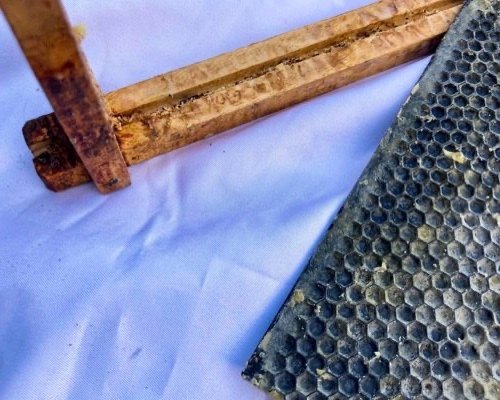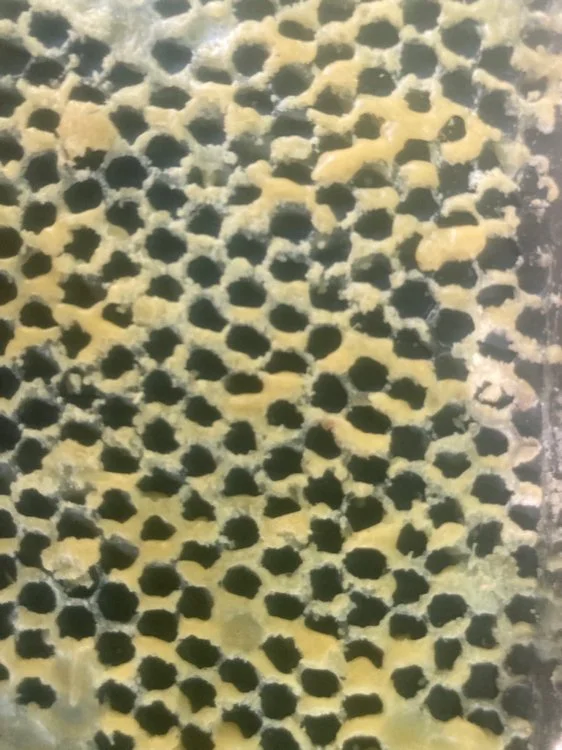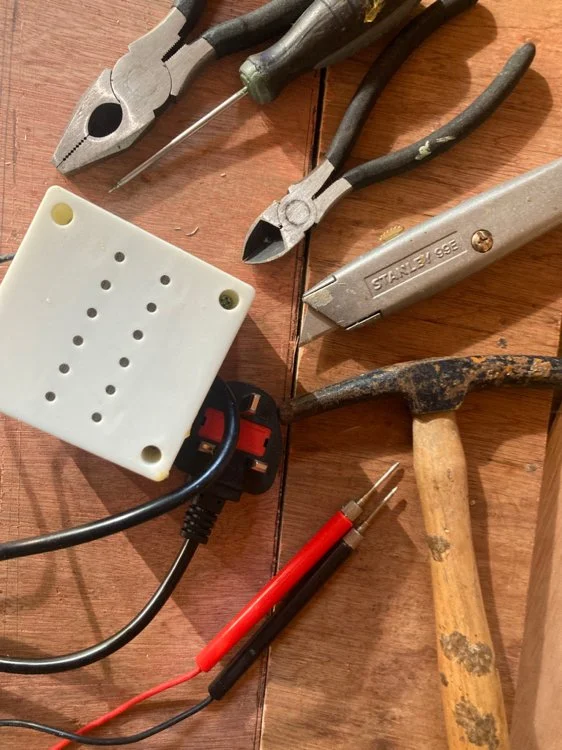
Frames and Foundation
Wood, wax and plastic
The basics
Frames are the oblong structures that hang in the hive on which bees make comb for storing honey or for growing eggs, larvae, pupae (brood). Frames come in various sizes to fit different hives. The default meaning of a wooden national frame is DN4 with wax foundation. The commonest plastic frames have plastic foundation surrounded by a wooden frame.
Super and brood frames, dummy board
The comb on super frame foundation is usually whitish and can be re-used many times to collect honey. If it becomes brittle, bees will soften it when you put it in their hive.
Brood frames become darker with age due to residues of pupae cocoons and propolis. Dark frames can be used for many years. However, since they become contaminated with toxins, most beekeepers replace them every 2 –3 years.
Dummy boards are slim frames that prevent bees from constructing brace comb in the space between the end frame and the inner wall of a box. They are unnecessary when using all in one plastic frames.
Manley frames (left) hold more honey and make harvesting easier.
Common frame shapes
Manley – make it easier to uncap honeycombs.
Hoffman – most commonly used.
No foundation - starter stick, strip, no strip
The comb
The hexagonal pattern pressed on foundation is either standard for workers or larger drone sized.
Come with or without embedded support wires – that prevent the fragile wax sheets of foundation from falling apart.
Foundation that is not wired is used for section honey.
Size
There are variations in Langstroth size between countries. Nationals are the most popular hives in England. In Scotland, Smith are widely used. They have shorter lugs than Nationals.
Wooden and Beebox Langstroth top bars are 482.6 mm (19”), bottom bars 446 mm (17 9/16”). They come in four frame sizes:
Jumbo 285.7 mm, 11 1/4”
Deep 230 mm (9”3”) 231.8 mm, 9 1/8”
Medium between 160 mm & 158.7 mm, 6 1/4”
Shallow 140 mm, 5 3/8”
Medium frames are effectively the same depth as Dadant & Modified Dadant shallows: Depth: Mediums 160, Dadant supers 159 mm, Modified Dadant 158.7 mm. I’ve seen170 mm sold as Mediums. In practice, they all equate to 158.75 (6 1/4”).
The Dadant brood frames match the Langstroth Jumbo. I’ve never heard of anyone using Jumbos.
National Hive frames: Top and bottom bars: 432 × 356 mm. sidebars:
Deep 215 mm
Super 140 mm
“14 × 12” 304 mm.
There are a mind-boggling number of variants: DN1 to DN5 and supers SN1 - SN5. Most people use “standard frames” = DN4 for deeps and SN8 for supers. For a full explanation, see beelistener.co.uk
Number of frames:
Langstroth: Hoffman wooden boxes come in two sizes:10 or 8 frame, Beebox: 10 Hoffman, 9 Manley, 8 Beebox Smart hive.
National: 10
Abelo/Lyson: 11 (old), 12 (new version)
Material – what the frame is made of
Wood and wax
Plastic
Wood and plastic
Plastic frame and wax foundation
White wax - National super (notice the longer lug), Dark Medium frame, Dummy board
Medium frame
National brood frame
Summary of plastic versus wood and wax frames
Both work well. Most people prefer the appearance of wood and wax. Unfortunately, wax is a soft material and not infrequently frames disintegrate when honey is being extracted. Plastic frames are tough and can be re-used ad infinitum justifying their initial expense. Contrast wooden frames, which are a fiddle to re-cycle and are often regarded as single use. Bottom bars not infrequently get pulled off during inspections. Bees draw comb on wax foundation with alacrity. In the UK, they can be slower to do so with plastic frames and require a honey flow or copious feeding. With meticulous waxing, particularly as a two stage process, this should not be the case.
The advantages of plastic frames
It is easier to see eggs on black foundation. Eggs are impossible to see in freshly drawn comb in frames without foundation.
Plastic frames moulded in one have a larger surface area than wooden ones.. For example, plastic Medium Dadant Shallow (medium frames) is 648 square cm versus National wax brood/deep foundation is 692 square cm.
The young brood is easy to see with opaque frames. If you must find eggs, you can. This advantage is lost with dark comb.
Assembly: no fragile wax foundation .
They are tough: I can stuff them into my rucksack & carry them to my out-apiary.
The comb is dead level. There are no nooks and crannies where the queen or queen cells (QC) can hide.
Bees cannot chew or make holes in them.
They do not blow out (fall apart) during honey extraction.
They last a long time
Option of using one’s own wax to coat them.
Suit any bee – not “Some bees don't like them.”
Langstroth Mediums handle with a nice balance, and the narrow profile gives the impression that your eyes have less distance to cover.
Plastic all in one Langstroth deeps can be cut down to mediums using a table saw. Subsequently, honey comb cannot be uncapped with a knife.
Plastic foundation can be used with wooden frames.
You can let wax moth clean your foundation.
Re-using them takes effort, but is quicker and easier than with wooden frames.
I have found it difficult to produce any drawn comb. Every year I have used most of my super frames to replace old brood frames. A friend overcomes this by feeding syrup in the Spring.
It is possible to retrieve crystallised honey from comb.
Wooden frames with wax foundation
Wax foundation is easily deformed, and sometimes bees chew holes in it. Since bees draw comb on wax foundation with alacrity, burr and bridge comb are common compared with plastic frames.
Wooden medium frames, require Modified Dadant shallow wax foundation, not Langstroth super foundation.
Waxing plastic frames is quicker than making up frames with foundation. Frames made to fit an oblong sheet of plastic foundation have gutters in the upper and lower bars. American frames usually have horizontal or vertical holes that need wiring. The wire has to be embedded in the foundation. See cwynnejones.com for frame sizes.
Quality frames with fine grain and no knots are derived from slow-growing trees, so if you are ecologically aware, you will need to find their provenance. “Seconds” have some knots and are likelier to break.
They are sold flat-packed and require assembly. They can be bought ready assembled for a price.
Stored wax foundation gets brittle and a little paler after a year or so. The brittleness should resolve once it is placed in the hive. Alternatively, the bees busy themselves gnawing holes,
Re-using wooden frames entails a lot of fiddling, teasing components apart after boiling them in a washing soda solution. Many people don’t bother and consider them single-use.
Bees take to them well and draw nice combs so rapidly that it looks like magic.
They draw combs before they are required.
Brace comb sometimes forms between wooden frames.
They weigh less than plastic frames.
Nationals have long lugs which are easy to hold.
National hives have small super frames. Honey combs are easier to uncap and carry.
It is easy to cut out QC.
Making up frames with wax foundation isn’t too painful for most people: watch a video. The presenter uses nine pins. Using four rather than two pins in the top bar is standard, thus using 11 pins per frame.
Wooden Nationals take ten Hoffman frames.
Wax foundation is fragile. During extraction, it sags like a sail billowing in the wind. If you drop a comb of honey there is a good chance that the comb will disintegrate.
When a bottom bar gets stuck to the frame beneath, it falls off.
19. The bee space between frames sometimes goes wiggly. Adjacent frames fit each other's wiggles, making moving frames to another position in the box impossible and there is a risk that bees get stuck when the frames are pushed together.
The frame spacing has been increased for the purposes of the photo.
Issues with plastic frames
All in one plastic frames have become unavailable (2025). So plastic foundation has to be clicked into wooden frames. Unlike wooden foundation, they don’t break. Waxing plastic foundation twice, initially with a roller and then with a brush, results in excellent acceptance. Cells that are full of wax do not get drawn unless they are poked to reveal the foundation.
Some beekeepers believe they are the work of the Devil.
Frames that are not waxed thoroughly do not get drawn. Some people prime them with minimal wax and report good results, but that has never worked for me. They need 45g—50g per frame, which is a further expense of £0.87 (2021). Getting the wax coating right takes a bit of practice. Rubbing them with wax is an easy, second rate alternative.
Like many manufacturing businesses, bees draw comb “just in time”. However, with finickiety double waxing they do, just like wax foundation. This is an important consideration.
They have a higher initial cost but are long-lasting: Wood frames with plastic foundation have become popular £4.62 compared with assembled wooden frames at £2.10 (2021).
The bees are reluctant to draw drone comb on worker foundation.
It is difficult but possible to cut out queen cells.
They are heavier. Waxed Medium plastic frames weigh 290 gm, and wooden frames with a wax foundation weigh 240 - 260 gm.
They are made from polypropylene (PP). My experience is that they deform at less than 82 °C. The closest figure I could find was 100 °C at 1.8 MPa (1.8 times normal atmospheric pressure—so the deflection temperature will be lower than this, about 90 degrees C). Deflection temperature of various plastics.
Like flower pots, black plastic cannot be recycled (other colours of thermosetting plastics can). So, currently, they end their lives in landfill.
The carbon footprint from manufacture is equivalent to 1.6 kg CO2/kg. However, this does not include oil extraction and transport, so it is more like 3–5 kg CO2 eq/Kg. It is lower than beef at 24–36 kg CO2 eq/kg—plastic manufacture results in small amounts of VOCs and NM-VOCs, which affect ozone levels.
All-in-one deep plastic frames are available for Nationals. The frames ca be cut down to fit supers. Ironically they have become almost unavailable for Langstroth (UK 2025). All in one Langstroth frames have become almost unavailable (2025). However, they are still available in Australia and the USA. Orders > £135 (+ delivery) can be purchased from Honey Paw in Finland for more than half this price.
If you know you will never be able to pick up queens (to clip and mark them), maybe because you have an impediment like an intention tremor, you will find a marking table helpful. This works best with shallow plastic frames.
Some people say bees “don’t like them”. Yes, on balance, bees prefer wax foundation, especially if plastic frames are not adequately waxed. When first using these frames, getting the waxing just right is challenging. Get it wrong, and sure, the bees don’t like it. I have used plastic with mongrels and four strains of honey bees without an issue …. in honey flows. Without decent amounts of sugar syrup or a strong nectar flow, they don’t get drawn. My suspicion is that prolific bees do well - based on watching YouTube, but some British, moderate bees struggle.
To get fresh comb, put frames of foundation between fully drawn comb. Otherwise, they may build a deep comb on one frame and none on the next.
Some advocate using wood with wax foundation as brood frames and plastic for supers. Others do the opposite. Their decision depends on their priority regarding the durability of the frames versus the ease of finding eggs.
Frames often get stuck to the ones above, especially in the spring. Top space hives don’t have this issue.
Brace comb between plastic frames is rare. If the hive is level, the comb is straight; it rarely deforms. A dummy board is unnecessary.
They sometimes fail to draw out the frame entirely before using it.
They warp if hot-washed.
They may disrupt vibrational communication? I have heard piping okay.
As the wax becomes darker, open brood becomes more difficult to see, just as with wax comb.
A honey flow or a sugar syrup feed is necessary to enable them to draw comb effectively.
Drawing wax / making comb
A large harvest depends on a good supply of drawn brood and super frames. A shook swarm or Bailey Comb Change encourage bees to do what you want. Without the correct conditions, they have other ideas, like absconding or sitting around doing precious little. Their Inactivity can arise from insufficient bees or cold weather, in which cases they prefer cosy cuddles.
Try using manipulations like a Bailey comb change or encourage them by placing foundation in the best position and feeding them thin syrup in the build up period.
-

Sheets of plastic foundation click into wooden frames. The embossed hexagonal pattern is deep in this foundation, which makes it difficult to wax with a roller. It is inadequately waxed.
-

Assembling fames and waxing plastic ones can take a little practice.
-

Deep frames can be cut to make medium frames.
-

Poorly drawn frame.
19. Wooden medium frame top bars are too long for Beebox hives.
The lugs need to be ground down, They clog grinder wheels 🙁.
20, Wax foundation buckles if it is left in the sun in warm weather
21. Both plastic and wooden frames have lugs (the bits that stick out at the ends of the frame). The protruding side bits may need spacers that ensure the frames are a bee space apart. The pins in one frame are wrongly placed. See the correct positioning.
Making up wooden frames
Fixing wax in wooden frames is difficult to begin with; it may be impossible if your fingers are the size of sausages. Ready-made frames are available.
Fixing foundation
Wax softens when it warms. If necessary, cool sheets of wax foundation in your fridge.
Once the frames are complete, store them upright in a cool place.
If a nail wants to go in a slightly wonky direction, don’t pull it out immediately, hit the top perpendicular to its direction of travel.
Keep practising, you will improve. Alternatively you may find imbedding wires in the foundation more straightforward.
The 3/4” nail is a popular size, it has a small gauge so that it is less lightly to split wood, but more likely to bend. If a nail starts to bend over, aim your next hammer blow in line with its new direction and it will find its way home.
Try using some sort of punch
Deformed foundation
If your frames soften and curl, it is almost impossible to straighten them. Here are some techniques I’ve tried:
If you find that the foundation is bowed after assembly, you could dissemble and re-make the frame. Alternatively, try to pull it straight. Before pulling on the wire hoops situated on the bottom of the foundation, make sure the wires are secure on the top bars. If necessary, hammer in more nails. Then pull the hoops down. If the foundation remains significantly curved, the bees will build rubbish comb. To prevent this, when making uo the frames, ensure the foundation is straight and cool.
Embedding wires in wax foundation
An excellent idea.
You need to buy a transformer to reduce the mains voltage to 10 - 15 volts. Then it is simple to apply the neutral and positive nodes, separated by a stretch of wire. The wire between the electrodes warms, and melts the wax just enough for the wire to half or totally sink in. Some people secure its upper edge with a dribble of wax. The technique takes a little while to learn. I demolished four sheets of foundation before I got the knack. The attraction of this method is that with the correct frames (horizontal wires) it is quicker and cheaper than using wired foundation. It lessens the need for fiddling, nails/pins, and sore fingers, Since the foundation is not fed through a slot it is not prone to bend.
Equipment for embedding wires into foundation.
Frames 1.























